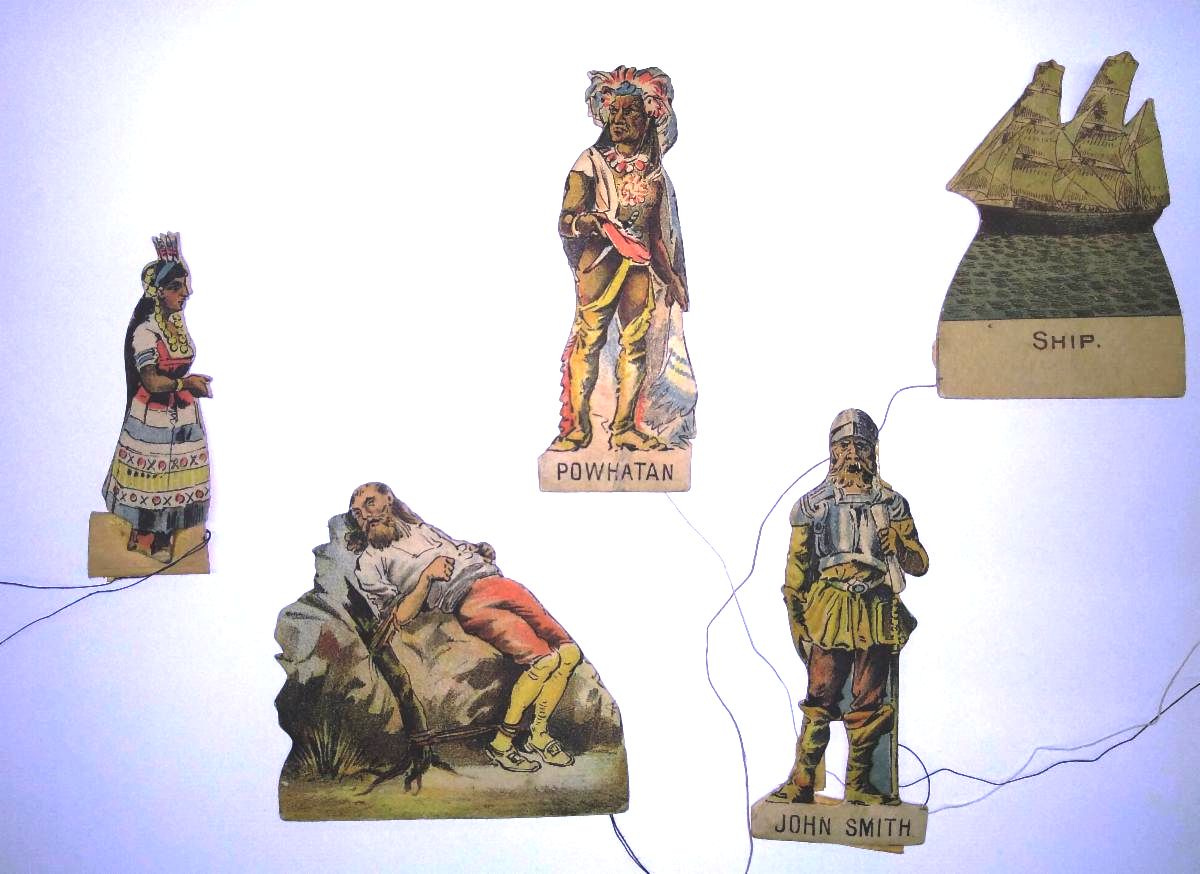A very little stage, in the case of this collection item.
ACHC #1980.073.14
This is an antique toy theater consisting of a rectangular, grooved wooden base, theater proscenium, stage backdrops, and multiple scenes, as well as 12 figures. The set pieces are made of printed, colored paper mounted onto cardboard. The figures each have a long thread attached. Our theater displays the sets of the stories of Captain John Smith and Pocahontas and of Robinson Crusoe.
ACHC #1980.073.14, Characters of Captain John Smith, Pocahontas and Chief Powhatan and the ship
Toy theaters appeared in the 1800s due to the increased popularity of theater and the growth in the printing industry. With the Industrial Revolution more people were moving from the country to work in cities. They sought some respite from the harsh factory conditions and tenement life. Plays and pantomime shows provided an escape.
As early as 1811, William West, a London printer, was printing sheets of characters and actors from London shows. Artists were sent to each opening show to sketch the actors, the scenery and sets, and annotate the script. Printers would then take the drawings and print the character and scenery sheets. Abridged scripts would be printed with notes of changes in action and scenery.
The single black and white sheets cost one pence; the colored ones, two pence. People would paste the sheets onto cardboard and then cut out the characters. They would build the little theaters with the grooved slots so the backdrops and scenery could be slid onto the stage. The character figures had threads or thin wires so that children (or adults) could pull the characters across the “stage” at appropriate times in the script. The "performers" would vary their voices as required for the different characters. Often, tiny oil lamps were used at the base of the wooden stages as “footlights.”
Generally, the toy theater plays were adapted from operas, melodramas, and pantomimes. “Hamlet,” “Blackbeard the Pirate,” and “Little Jack Sheppard,” a burlesque melodrama were among the favorites. Not exactly children’s stories. However, some Hans Christian Anderson’s stories were also adapted. At a time when some London live theater ran 5 hours, the toy theater scripts ranged from 3 to more than 50 pages!
The small theaters became fashionable all over Europe. Between 1820 and 1930, theaters were manufactured in England, France, Germany, Austria, Spain, Denmark and the United States. The theaters provided a distraction, piqued the imagination of children, and were a way for people to feel connected to their admired actors and to relive the theater experiences.
Toy theaters remained popular through the 1800s and into the early 1900s. Made of paper and subject to repeated play, not many toy theaters survive. Those that have survived are in the hands of collectors or museums. However, today there are artists and craftspeople throughout the world who are reviving the art and making toy theaters once again.
With the continuing pandemic restrictions on live theater perhaps Broadway shows will be coming to toy theaters near you!
What's your favorite? What would you like to see?







